Why Do Crested Geckos Curl Up Their Toes? Check Him Out!
If you see your crested gecko curling its toes while it’s running or climbing, don’t worry! That’s perfectly normal. However, geckos could also keep curling their toes weirdly for a bad reason.
Normally, crested geckos curl their toes upward to detach their feet from a surface. They also temporarily curl up their toes to remove dirt, get rid of shed, and reduce pain. In rare cases, gecko toes may be permanently bent due to genetic defects.
But how exactly can you differentiate between a normally curled crestie toe and a weirdly curled one? Plus, how can they bend back their toes like that without any pain? Do crested geckos have bones in their toes? Find out as you read on!
1. Grip Release
A crested gecko will curl its toes to release its grip while walking or running on a nearly horizontal surface for fast movement. They naturally curl their toes up when they are standing on relatively flat ground or preparing to jump as well.
Similar to other arboreal or tree-dwelling geckos, cresties have specialized toes that allow them to walk on walls and ceilings. Terrestrial species like leopard geckos, in comparison, don’t have sticky toe pads. Instead, they have slender toes with small claws at the end.
Crested geckos have wide toes that have microscopic hairs that branch into even tinier and thinner bristles. These allow cresties to stick to surfaces and objects on a molecular level!
Learn more about this in greater detail in our article on how geckos walk on walls.
When their feet are flat on the ground, cresties can securely stick themselves onto things [1]. Then, these geckos will simply detach the fine hairs binding them to you or any other object by curling their toes up once they want to release their grip to move or jump.

You may also see them doing this while they are standing at the bottom of their tall enclosures, while they have all four of their feet directly on the substrate.
They also curl their toes inwards while climbing steep and vertical surfaces like wood branches and glass walls. But since they would fall unless they hold onto the object they are clinging to after each release, they curl and uncurl their toes faster.
If crested geckos never curled their toes up, then it would be impossible for them to even move an inch because of how well their sticky toe pads allow them to adhere anywhere!
2. Dirt Removal
Sometimes, crested geckos will curl and uncurl their toes to get rid of dirt, substrate, and food. Dried-up food may also cause a gecko’s toes to look bent, misshapen, or stuck together.
Just like us, crested geckos tend to lift and curl their toes again and again when they get something stuck on and in between their toes. One friend of mine has even seen his crestie doing this while it had its toes soaking in its water bowl—proof that they’re pretty smart!
Besides that, many beginner crestie keepers worry themselves overseeing how weird their scaly baby’s toes have become only to find out that it’s all because of dried gecko food.
A lot of crested geckos kept in captivity are primarily fed with powdered crested gecko diets mixed with water and then served in small bowls or bottle caps. So it’s not really that uncommon for them to walk into their food bowls and get it all over their feet.
However, if a thick layer coats their toes, they may not be able to easily remove it on their own—especially when it is already very dry and hard.
Typically, giving a crestie a 5–15-minute shallow bath or sauna session with help dislodge the dried food. Depending on how much food got stuck in their toes, you may have to repeat this. While it’s still wet, you can also help gently rub it off with a damp cotton swab.
If, after doing all that, your gecko still has hardened food on its toes, don’t worry. All the dirt stuck on their toes will likely be gone after a successful shed—which brings us to the next reason.
3. Shed Disposal
Crested geckos will curl and uncurl their toes to loosen their shed and remove it. Other times, accumulated shed at the end of their toes may look bent and swollen.
More often than not, seeing a crested gecko curl and uncurl its toes should be no cause for concern—especially when they are in the middle of their shed cycle.
For a visual comparison, imagine yourself whenever you’re changing clothes. Neither your body nor fingers would stay slack for that, right?
To remove your dirty clothes, you’d need to wiggle yourself out of them. Cresties do pretty much the same thing!
Once the old skin covering their bodies has been safely separated from their newly formed scaley skin, cresties need to move around not only their toes but their whole bodies.
Although crested geckos primarily use their mouth to tear off their shed, they also bend straighten their limbs and curl their toes for better removal.
During this time, newbie crestie owners usually get worried since their geckos may refuse to climb and explore their decked-out tanks. They may also keep walking on the substrate with the very tips of their toes all curled up—which some owners lovingly refer to as elf shoes.
However, if you notice their toes start getting thicker than normal, inspect them closely. They may have several layers of unshed skin building up on their toes which could result in toe loss. Prevent this from happening by keeping their tank humidity within 50–80%!
Explore other ways to maintain optimal humidity in gecko tanks!
4. Pain Reduction
To reduce pain and avoid adding pressure to injured toes, crested geckos will lift and curl their toes. Oftentimes, injured gecko toes are noticeable as they may bleed or develop discoloration.
If you’ve ever had a cut on your toes, you could probably guess why a crested gecko would curl up its toes rather than lay it flat on the ground even if it’s just standing still.
But if you’re lucky enough to never have experienced that, the reason is quite simple.

Injuries could hurt more when too much pressure is added to it while it’s being continuously used to support the gecko’s weight. They’ll likely walk weirdly—limping—and have trouble climbing plants and cork tubes as well, making their toe problem even more obvious.
You see, although a bit of pressure can help stop cuts from bleeding, it can worsen the pain from other injuries caused by blunt trauma. Either way, it’s best to consult a veterinarian for proper assessment and treatment.
For cresties, I found that one of the most common causes of blunt trauma injuries to their toes is caused by having tank decors fall onto them. Another possibility is having their tank doors close on their toes.
Such injuries often result in swelling of the injured toe followed by discoloration—from reddish purple to black.
5. Genetic Defects
In rare cases, a crested gecko may develop an unusually curled toe from birth due to genetic mutations. Deformed toes caused by genetic defects are permanently curled.
Frankly, I’ve only ever seen one picture of a crested gecko with permanently curled toes due to genetic mutations, and that was from years ago. So I’d say it’s more common to see a crested gecko with two heads than it is to see one with unusually bent toes.
As such, I won’t rule this out completely as a possible cause of curled toes in cresties—or any other gecko, for that matter. But I did put this at the very unlikely.
If your gecko does have such a genetic defect, you will see its deformed toe right after it hatches. Moreover, the position of such a permanently curled toe will not change as it moves around the cage.
However, whether or not it has problems walking or climbing will depend entirely on the severity of the malformation.
What Do Normal Crested Gecko Toes Look Like?
Crested geckos normally have 5 toes on each webbed foot that have curved claws on each end. Unlike ground-dwelling geckos, crested geckos have wide toe pads which are composed of 2–4 small bones connected by highly flexible ligaments.
As I’ve mentioned above, cresties also have incredibly thin and tiny hairs on their toe pads which allow them to scale tall walls and structures. They can technically defy gravity as well, walking upside down.
But what I find even more fascinating is their feet’s musculoskeletal structure!
Far from the regular human—or even the average leopard gecko—cresties are actually double-jointed!
Just to be clear though, this doesn’t mean they have two joints between each bone on their toes [2]. Remember, ligaments are what connect bones together, while joints are just the areas where the bones meet.
Crested geckos mostly have 2–3 bones on each toe. However, their fourth toe which is equivalent to our ring finger has 4 bones.
The ligaments connecting these small bones together are very flexible, making them “double-jointed,” which allows them to curl their toes up and in without hurting themselves.
Further Questions
Are curled crested gecko toes related to metabolic bone disease?
Metabolic bone disorder, MBD, or hypocalcemia will not cause crested geckos to curl their toes. Their toes can naturally bend backward. Hypocalcemia primarily affects the bones in a gecko’s jaws and limbs. But if most or all their toes are permanently bent and they can no longer walk, climb, or grasp things, get them examined by a veterinarian.
Do geckos curl their toes when they are stressed?
Some gecko owners believe that geckos curl their toes when they are anxious or stressed there is no evidence to support this claim. Geckos mainly just curl their toes up and down to move. Other times, they curl their toes around an object they want to cling to.
Is it normal for gecko toes to swell up?
Swelling around the joints of a gecko’s toes, arms, and legs is generally a sign of illness. Their joints may swell due to an injury or due to gout. In the latter case, uric acid crystals form and accumulate in a gecko’s joints.
Summary of Why Crested Geckos Curl Up Their Toes
Grip release, dirt removal, shed disposal, and pain reduction are the primary reasons why crested geckos repeatedly or temporarily curl their toes upward and inward. However, there are rare instances where geckos have one or several toes permanently curled up due to a genetic defect.
A crested gecko’s normal anatomy allows it to painlessly curl its toes up without feeling any pain or discomfort whatsoever. This is possible because the ligaments joining the small bones in its toes together is extremely flexible.
Sources
[1] https://www.nature.com/articles/35015073
[2] https://www.livescience.com/33186-double-jointed-people-hypermobility.html

![Can You Have a Gecko and a Cat Together? [Yes, But…]](https://www.reptilehero.com/wp-content/uploads/2021/11/Gecko-and-cat-together-cc-768x614.jpg)


![How to Choose a Halogen Lamp for Your Leopard Gecko [In-Depth]](https://www.reptilehero.com/wp-content/uploads/2021/07/word-image.jpg)

![Taking Care of Geckos During Power Outages [Final Guide]](https://www.reptilehero.com/wp-content/uploads/2021/04/Gecko-Care-Power-Outage-768x614.jpg)
